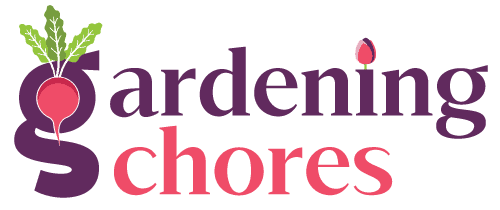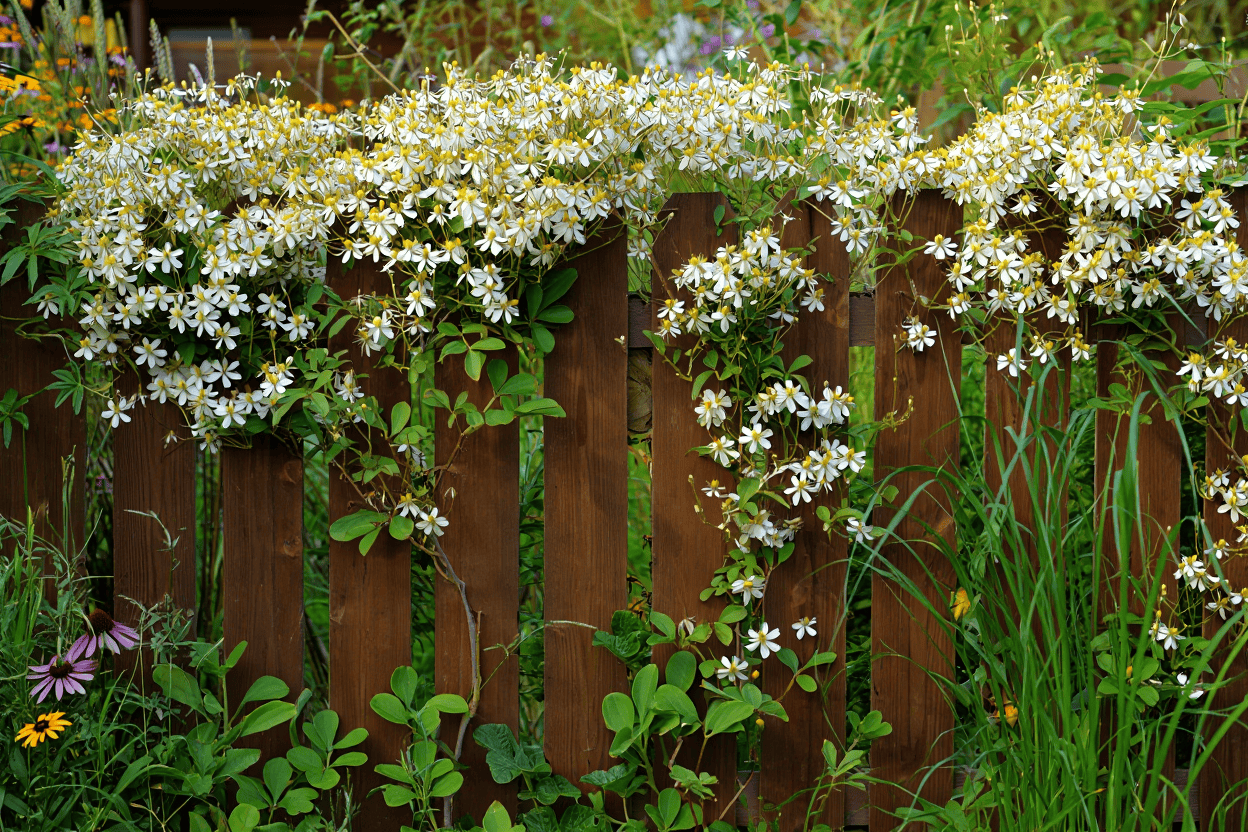
I know the feeling on seeing butterflies fluttering and dancing over flowers gardens – and I’m sure you share that sense of flying with them too. But how can you follow them up to the sky if they only dance over the blooms of short annuals and perennials? You need vines to watch them soar up towards the heavens – and local, native varieties are best.
In the end, Nature created many local “families of plants and animals” – if you pick a native variety of climber or vine, butterflies will be much more likely to be adapted to it, and come to visit you.
But which varieties of vines and climbers coming from North America are best to feed and attract butterflies to your garden? Let’s find out!
1: American Wisteria (Wisteria frutescens)

Let’s start big! American wisteria is actually native to Southeastern U.S. (VA to FL, west to TX), and of course it will attract local butterflies, like the silver-spotted skipper (Epargyreusclarus), but many other species too. Like you and me, they are attracted by the super fragrant, pale lavender to blue violet hanging clusters of pea-shaped blooms that reach 6 inches long (15 cm). A massive display of romantic flowers and winged visitors (long tongued bees too) will fill your garden from May to June and then? Then you will be left with the amazingly decorative pinnate foliage, finely textured, shade and spectacular vine!
Less vigorous than Japanese and Chinese varieties, American wisteria can still grow to 15 to 30 feet tall (4.5 to 9.0 meters) and it’s cold hardy to USDA zone 5. Ideal for an arbor that fills with blooms, fresh foliage and local butterflies.
2: Climbing Hempvine (Mikania scandens)

On to a totally different vine, and different season. Climbing hempvine will attract butterflies in August, September and October, when it is in bloom. Its clusters of white little flowers will feed our winged friends and other pollinators with their sweet nectar, especially swallowtails (Papilio spp.) and kippers (Hesperiidae spp.). Imagine them dancing over clods of fluffy flowers in white to pale lavender pink! Shade tolerant and native to Eastern and Southern US states it has lush, herbaceous, rich green and heart shaped foliage – a nice addition to your garden.
Ideal for a naturalistic garden climbing hempvine grows fast, but only to 6 to 10 feet tall (1.8 to 3.0 meters). In fact, you can keep it as an annual and cut it back in winter (it is very prune-friendly), though it is hardy to USDA zone 6.
3: Coral Honeysuckle (Lonicera sempervirens)
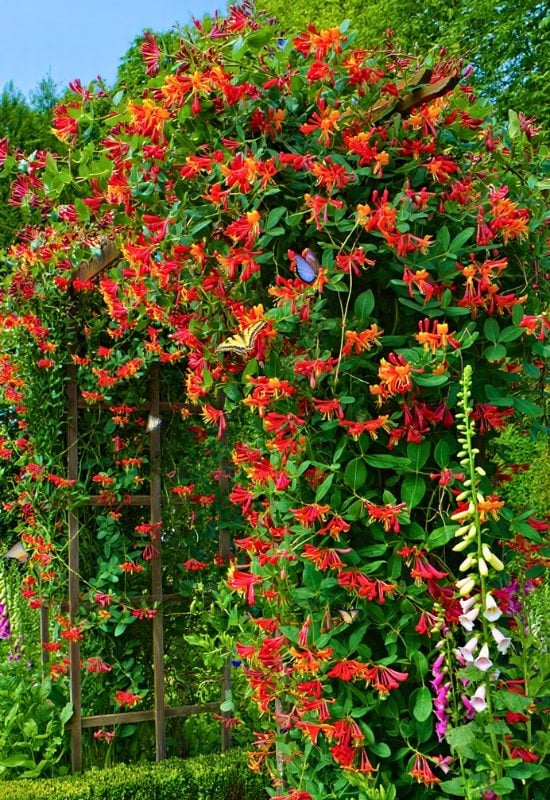
What a wonder is coral honeysuckle! It looks like its tubular blooms with “lips” red and yellow appear in April and persist till July – all set on a backdrop of lush, finely textured, pinnate foliage – and they may flower again sporadically. For us, it’s a wonder, for butterflies (and hummingbirds) it’s a long-lasing source of food! Especially appreciated by swallowtails (Papilio spp.) and spring azure (Celastrinaladon), it will also provide food for little birds with its berries in fall.
While coral honeysuckle looks so exotic to us, it is actually native to the East Coast, all the way from Massachusetts to Florida, and it is quite cold hardy (to USDA zone 4!) and evergreen in mild climates. It can grow fast to 10 to 20 feet, but it is very prune-friendly if you have a small garden.
4: Virgin’s Bower (Clematis virginiana)

Native to the Eastern and Central USA, virgin’s bower is a white clematis, blooming from July to September with white 1 inch wide flowers. It is ideal to attract small butterfly species to your garden, but also bees and moths – because at night it is fragrant! Very easy to grow and reliable, this vine is an ideal choice for a long floral (and fluttering display) with no hassle. It will also offer you airy and delicate foliage through the season.
While it blooms best in full Sun, virgin’s bower also tolerates part shade, and it is very cold hardy indeed, to USDA zone 3.
5: Pipevine (Aristolochia macrophylla)

Spectacular and exotic, pipevine too is a super exotic-looking vine native to the Eastern USA and attractive to butterflies. But one species particularly depends on it, because this climber is its sole source of food, and it takes its name from it: pipevine swallowtail (Battusphilenor). It will appear when it’s in bloom, from May to June, with very weird, pipe shaped flowers, that try to hide in the lush, cordate foliage. Unsuccessfully though, because how can these blossoms hide their massive roughly heat shaped openings, which are deep purple with yellow veins and reach 10 inches across (25 cm)?
And pipevine does bloom profusely – this climber will be the protagonist of your garden for months, and, despite its super exotic look, it is shade and cold tolerant (USDA zone 6), and fast growing, up to 30 feet tall (9.0 meters); just cut it back if you need.
6: Carolina Jessamine (Gelsemium sempervirens)

If you want to provide “breakfast” to butterflies and other pollinators, Carolina jessamine is ideal, because its bright yellow, trumpet shaped flowers appear abundantly in February (even earlier in the South) and they keep coming till April. Especially attractive to cloudless sulphur (Phoebissennae) and other early spring species, this vine’s blossoms are also very fragrant, with a very sweet scent. A lovely display on the dark green evergreen foliage backdrop.
Cold hardy only to USDA zone 7, Carolina jessamine will grow to 10 to 20 feet tall (3.0 to 6.0 meters), but slowly. If you want a vine to attract butterflies to your garden early in the season, now you know which to pick. But be careful, while its nectar is good for our winged friends, all parts of this plant are toxic if ingested!
7: Virginia Creeper (Parthenocissus quinquefolia)
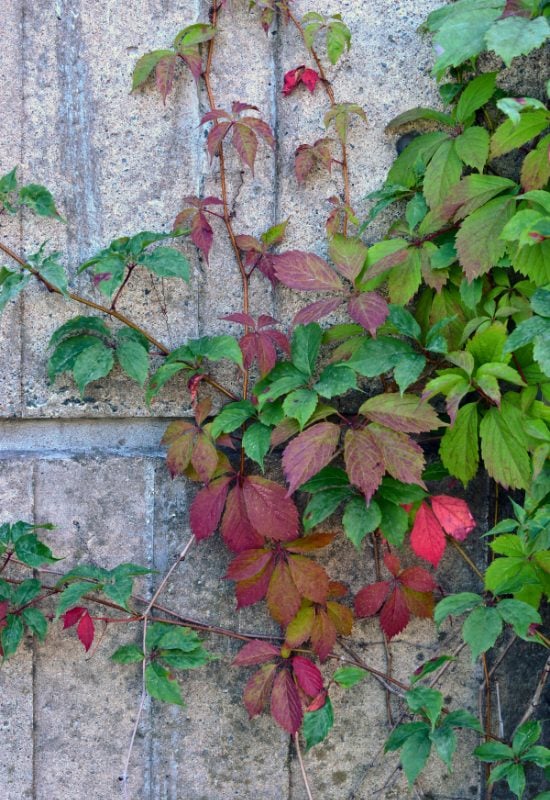
You can grow Virginia creeper as a climber or ground cover, in both cases, it will attract butterflies to your garden when it is in bloom, from June to July. This vine is particularly useful for one species, Virginia creeper sphinx moth (Darapsamyron), because it depends on it as its sole source of food. Ok, its flowers are really tiny, and you will hardly notice them, in fact, its gardening value rests in its dense foliage, which turns red in fall. But when the season comes to a close, it will also attract other winged friends to your green haven – birds! In fact, it will produce lots of sweet black-blue berries…
Native to the Eastern and Centra USA, Virginia creeper can grow to 20 to 50 feet tall (or wide), or 6.0 to 15 meters! If you grow this vine as a climber, make sure you use a trellis, because it can damage walls and fences! Having said this, it is also shade tolerant and cold hardy (to USDA zone 3) and it’s ideal for a woodland garden look.
8: Trumpet Creeper (Campsis radicans)
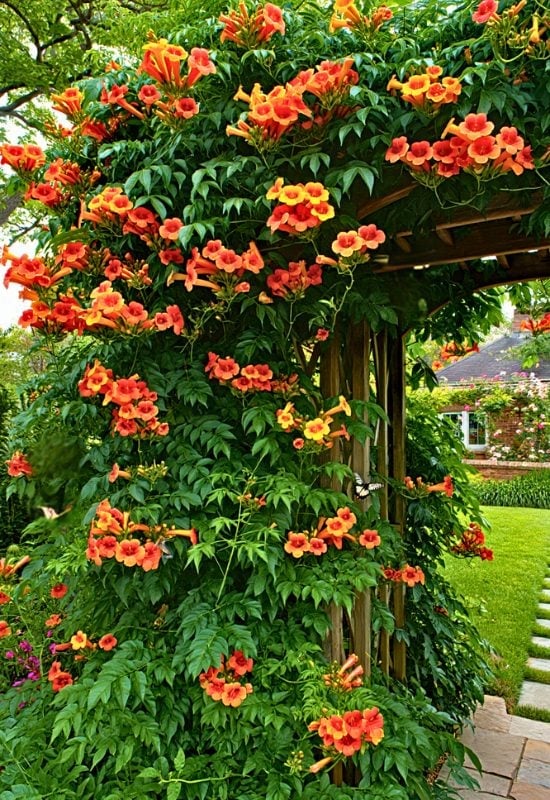
It’s called trumpet creeper, but it’s a wonderful climbing vine native to Eastern and Central US states and a favorite with hummingbirds! One of my favorite vines too, it is also a magnet for butterflies, including the tiger swallowtail (Papilio glaucus)! But let me tell you what it can bring to your garden, apart from flying visitors. It grows fast, producing a rich bright green wall of finely textured pinnate leaves. Come June, the 3-inch-long (7.5 cm) orange red blooms will open, and their flared mouth at the end of the trumpet shaped blossom is an invitation that pollinators cannot resist. There are also yellow cultivars nowadays. Whichever variety you choose, the floral display will continue into September – so, you too will have a long-lasting gift. And the stems look quite pretty in winter as well!
Very vigorous, trumpet creeper can grow to 20 to 40 feet tall (6.0 to 12 meters), so, you may have to cut it back every now and then. Hardy to USDA zone 4, it can bring its exotic beauty and fluttering butterflies to gardens even in some of the coldest regions of the USA and most of Canada.
9: Wild Potato Vine (Ipomoea pandurata)
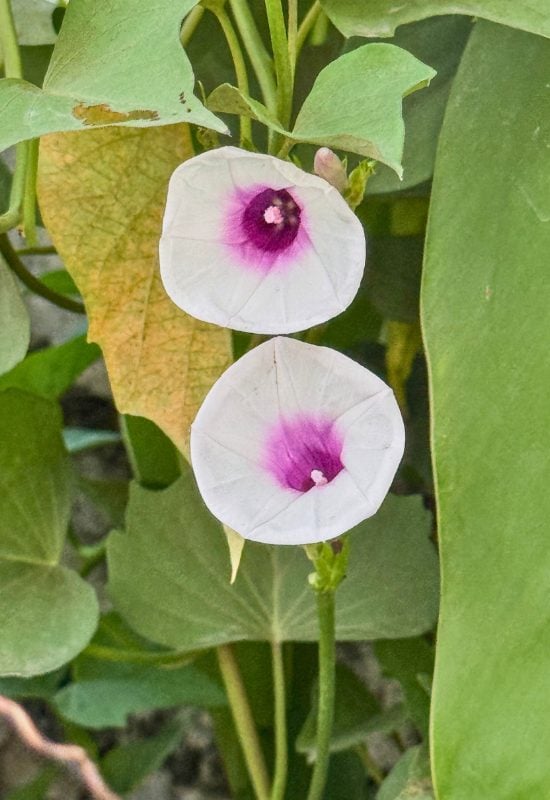
Both a climber and a creeper, wild potato vine is native to Eastern and Central US states, and it will bloom continuously from June to September, with large funnel shaped flowers that reach 3 inches across (7.5 cm). Snow white with a bright purple throat, these blossoms will definitely attract all sorts of pollinators to your garden, including lots of butterflies and especially hairstreaks (Satyrium spp.). But that’s not all you get… You will definitely enjoy the dense rich green and heart shaped leaves, big and lush, and ideal for privacy or to cover ugly sights.
Very fast growing and vigorous, wild potato vine can grow to 15 to 30 feet (4.5 to 9.0 meters) in a year, but it has thin vines, so easy to cut back. It is also cold hardy to USDA zone 5, and it can spread fast and naturalize – a real treat for local butterflies!
10: Milkweed Vines (Matelea spp.)

Now we come to the strangest of all our climbers, milkweed vines! This is a whole genus, Matelea, with species native to many states of the USA, Canada and from Mexico too. The fact is that the fleshy flowers look “alien”. Some are fairly regular, but I would understand you if, looking at others, you may think a starfish has crawled out of the see to shade in your garden. The colors too are often unusual, like maroon, deep purple (almost black) and green. But this odd appearance will not fool butterflies, of all sorts and including the monarch (Danaus plexippus) and the queen (Danaus gilippus) when in bloom, from May to August. On the other hand, the foliage is dark green, lush but with a more common shape, oval to elliptical.
Fast growing to 6 to 15 feet tall (1.8 to 4.5 meters) milkweed vines are cold hardy to USDA zone 5 (depending on the variety), and ideal if you want butterflies, but also an unusual-looking climber in your garden.
11: Cat’s Claw Vine, or Yellow Trumpet Vine (Doxantha unguis-cati)

Your garden will light up with the golden color of the sky if you grow cat’s claw vine – and lots of dancing butterflies too. Ideal if you live in a southern state, this climber is native to Texas, Florida and Mexico, and it blooms all the way from April to August with loads of large trumpet shaped flowers that reach 3 inches in length (7.5 cm). Of course, butterflies including the giant swallowtail, or Papilio cresphontes (and hummingbirds) cannot miss them – nor will your neighbors. The bright green, glossy leaves give the ideal backdrop to this amazing display!
Growing to 20 to 40 feet tall (6.0 to 12 meters) cat’s claw vine is ideal to drape walls and fill them with butterflies. It’s only drawback is that it is not cold hardy, only to USDA zone 8.
12: Crossvine (Bignonia capreolata)
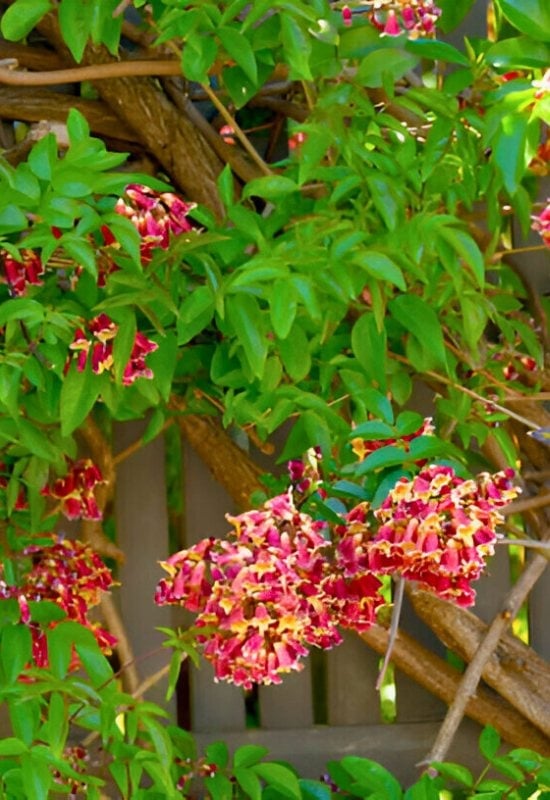
Blooming in March and May, and sporadically later on, crossvine is a great source of food for early butterflies, like the spicebush swallowtail (Papilio troilus). Its tubular flowers flare at the bottom and they are dark purplish red outside and in the throats, but with saffron yellow openings – an invitation to dinner for flying visitors, including hummingbirds! Native to the Southeast of the USA, this climber also has semi-glossy, elliptical leaves that form a really dense curtain. Evergreen in warm climates, in colder regions, its peeling bark will offer interest in winter.
Cold hardy to USDA zone 6, crossvine is very vigorous, and it can grow to 30 to 50 feet (9.0 to 15 meters) very fast, so, you may have to prune it back quite regularly if you have a small garden
…And a Final Flying Tip
So, here are 12 amazing native vines and climbers to attract butterflies to your garden, but I want to leave you with a final tip… Remember to grow as many flowering varieties as possible to keep winged visitors coming to your garden, and to clump them – they don’t like to find a restaurant closed, nor to travel too far from the first to the second course!

Written By
Amber Noyes
Amber Noyes was born and raised in a suburban California town, San Mateo. She holds a master’s degree in horticulture from the University of California as well as a BS in Biology from the University of San Francisco. With experience working on an organic farm, water conservation research, farmers’ markets, and plant nursery, she understands what makes plants thrive and how we can better understand the connection between microclimate and plant health. When she’s not on the land, Amber loves informing people of new ideas/things related to gardening, especially organic gardening, houseplants, and growing plants in a small space.
